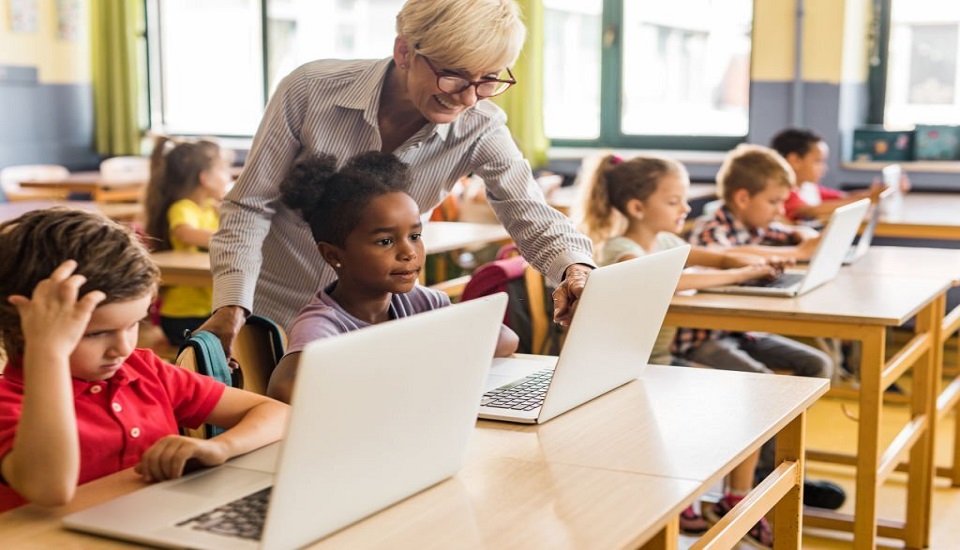Technology in the classroom is one of the biggest attributes of the modern educational system. Integrating technology in a classroom course is providing all the necessary equipment to teachers so that they can get along conveniently with this digital learning model. Technology empowers teachers and it enhances the student learning experience as well. Technology integration in the classroom has literally upskilled the learning management system where both teachers and students are enjoying lots of perks.
There has always been a debate that how has been education before and after technology. Call spade a spade, every coin has two sides, and similarly, the impact of technology has gotten both pros and cons in the modern educational system. Considering the pandemic situation when online education was the only ray of hope amidst the terrific lockdown period. Thus, e-learning has become technology friendly so as to make it hassle-free for every person as education is a fundamental birthright.
WHAT IS INTEGRATING TECHNOLOGY IN A CLASSROOM?
In short and crisp, integrating technology in a classroom enhances the quality of education that is imparted to students. It includes the use of various gadgets like smartphones, computers, digital boards, whiteboards, projectors, laptops, and so on. Besides, it creates pathways for special instruction to meet the unique needs of students as individual learners within an inclusive classroom.
A virtual classroom is one of the effective formats of a technology-integrated classroom. The benefits of technology are impeccable and there are pretty simple ways to integrate technology in the classroom. It helps in gaining the skills educators are looking for in this digital era.
HOW DOES TECHNOLOGY BENEFIT EDUCATION?
Well, it is uncountable in numbers but let me enlist the ones with major significance.
- The engagement of students has increased to a huge level.
- The outcome is fabulous in terms of students’ scorecards.
- The need to travel to colleges/schools have reduced to a great extent.
- Virtual classes can be conducted in a time and space flexible schedule.
- Multiple online video conferencing are available free of cost like Google Meet, Zoom meet, etc.
- Students learn different styles of solving problems.
- Assignments can be checked online and hence, accuracy is better.
- Students work in groups and thus, a sense of teamwork is encouraged.
- Learning materials can be accessed from anywhere having a good internet connection.
- ERP software for educational purposes is hassle-free and can operate on smartphones as well. It, therefore, reduced the dire demand for laptops or desktops.
- Students can learn at their own pace.
- Data security is top-notch and can be stored in Google Drive easily.
WAYS TO INTEGRATE TECHNOLOGY CLASSROOM:
Well, to begin with, strategies for technology-based classrooms have to be implemented keeping in mind the age of students and their potential. Strategies should be different for elementary students, middle, and high school students.
For young learners, technology can be used to build fundamental skills to prepare them self dependent in the future. Students can use interactive games to reinforce math, spelling, pronunciations, and practice skills outside the classroom as well. Students at the middle school level will become independent by having separate teachers for each subject. Technology can be used to acquire skills such as conducting research that can be applied to any content area.
Learn the importance of perfect pronunciation
Teachers can discover ways to use technology so that high school students can be beneficial for college and career development. Familiarization with Microsoft Office and Google Drive teaches students to make spreadsheets, slide show presentations, and share documents where they can receive solid feedback on their work.
Based on these strategies, various approaches are being suggested by experts that can elevate the student learning experience to a huge level.
Assigning homework online on learning platforms like Blackboard, Brightspace, and Moodle is a fantastic way many teachers can begin to integrate technology in the classroom. These assignments are easily accessible and available, which increases student engagement and helps students become more organized.
There should be a smooth flow of communication between parents, teachers, and school administrators. This facilitates a clear view of how a student is performing at school. Online grading systems such as PowerSchool open and enables lines of communication where teachers can post grades, analyze student attendance patterns, and provide concrete feedback.
For students who are privileged to have tablets from school, technology using those tablets can allow teachers to implement differentiation throughout instruction. Students can work at their own pace during assignments and teachers can have a conversation with them at a 1:1 version.
Powerpoint presentations using either Google slides or MS Powerpoint can be used to introduce a classroom concept while providing the opportunity for active student participation. Along with the use of graphics and bulleted information, links to videos that accompany the brilliant ideas presented in the Powerpoint can be attached to the slides.
There is a misconception that digital classrooms or technology integrated classrooms are quite expensive. However, the reverse is the truth. There are plenty of resources and tools available online and those are completely free of cost. Google products like Google docs, Google Slides, Google Spreadsheet, Google Classroom, etc., are absolutely free of cost. The premium version of MS office is only suitable for corporate affairs and that is why the free version if fully utilized by teachers and students, can be a monumental deal.
Integrating technology in a classroom course has prepared the learning materials with hands-on experiences so that teachers can learn every nitty-gritty of digital classrooms. This concept of a technology-based classroom is extraordinarily impactful and has generated efficient results everywhere. That is the reason why educators are encouraging this model of education. In fact, the record has shown that this approach is extremely beneficial for teachers and students.
Written By : Soma Adhikari















